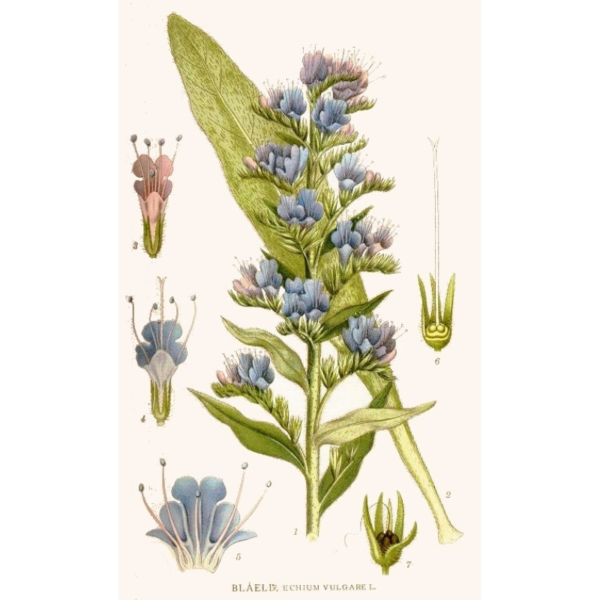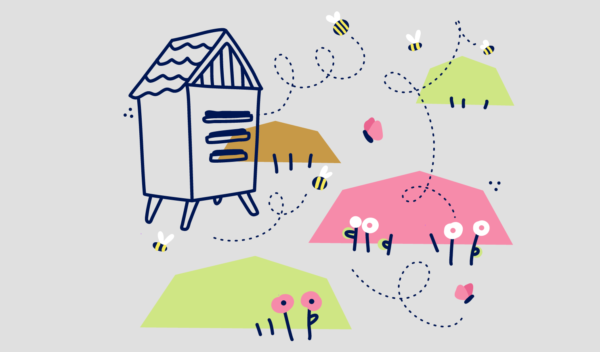Biennial, but very impressive species with a very hairy habit and purple, then (after pollination) blue or navy blue flowers. An excellent species for bee pastures and urban flower meadows, valued by bees and other hymenopterans. Wild, non-cultivar form.
SKU: N043
7,00 zł – 28,00 zł
SZYBKA WYSYŁKA
Zamówienia wysyłamy w 24h by każdy zakup dotarł do 3 dni roboczych.
BEZPIECZNE PŁATNOŚCI
Gwarantujemy bezpieczny, wygodny i szybki sposób dokonywania płatności.
POMOC I WSPARCIE
Oferujemy bezpłatne doradztwo i kompleksową opiekę pozakupową.
GWARANCJA JAKOŚCI
Dostarczamy profesjonalne i przemyślane mieszanki nasion.
Polish name: common viper’s bugloss
Nazwa łacińska: Echium vulgare L.
Family: the borage family (the forget-me-not family) Boraginaceae
Status in Poland: native, very common
Viper’s bugloss is an impressive biennial plant with shaggy stems and leaves, characteristic discoloration of flowers, and beetroot-like roots.
In the first year it produces a thickened root and a rosette of leaves. In the second year it develops a thick, usually erect, flower stem, 1 m high, covered with warts and two types of hairs. Long, protruding and bristly hairs grow out of red warts; while short and laying down flat hairs grow from the entire surface of the stem.
There are two types of viper’s bugloss leaves: the basal and the upper ones. The basal leaves are long, oblong, with petioles. The upper leaves are getting shorter and shorter, shortening to bracts as they approach the inflorescence, sessile (without petioles), more ciliated than the basal ones.
Protandrous flowers are red or purple in young age, blue or navy blue in old age, they grow in the leaf axils, forming a huge scorpioid cyme. The change in flower color is related with the change in the pH of the cell juice in these organs. The petals of the corolla fuse into a tube shorter than the calyx, opening with asymmetrical lips. The pistil and the stamens of the flower with a characteristic red color protrude from the corolla, which resembles a bifurcated tongue of a viper (hence the Latin and Polish names of the genus, hence the belief in the healing properties of these plants when consumed after reptile bites). Viper’s bugloss blooms longer than its relatives: from June to October, even November. It is mainly pollinated by large bees: bumblebees, cuckoo bumblebees, honey bees, and the larger solitaries. Cross-pollination guarantees good seed germination.
Fruits in the form of a triangular schizocarp, splitted into 4 dark brown papillary mericarps with serrated edges. Viper’s bugloss is easy to mistake with the purple viper’s-bugloss planted by beekeepers. In the purple viper’s-bugloss only two stamens protrude from the corolla, in the viper’s bugloss – four; and the base of the leaves is cordate, like some plantains (hence the Polish name).


Sowing these seeds is a pure pleasure: you can sow almost all year round (from late autumn, through early spring, spring, summer, and fall), as long as it is 10 mm deep into the ground. For beekeeping purposes, it is worth sowing it in warm, dry, permeable, and barren places. It can also be propagated by cuttings. The reaction doesn’t matter. In fertile and moist soils it shrubs abundantly, but blooms poorly. In the era of droughts and global warming, the low demand of this plant for water and nutrients becomes a great advantage. Ornamental varieties are trimmed after flowering.
Viper’s bugloss is an ancient crop species, planted in Poland and feral since antiquity. It was used to make oil and rat poison. The whole herb was used as an antidote for viper venom, for epilepsy, acne, for persistent cough, for badly healing wounds, and as an anesthetic. Amatour treatment with viper’s bugloss is very dangerous, it leads to liver and brain damage, which is manifested, among others, by delusions. A number of ornamental varieties of this bugloss have been bred. They differ from wild type in habit (often dwarf) and/or color of flowers (navy blue, purple, pink, white).
Due to the prickly bristles and the poisonous herb rich in alkaloids and silica, most herbivores avoid viper’s bugloss. However, it is preyed by painted lady caterpillars and some specialized bugs and beetles. The youngest and most delicate slimy leaves were also eaten by humans despite their toxicity.
In California viper’s bugloss is still considered one of the best honey plants. It is valued for the unusual structure of flowers, protecting the nectar from washing away by rainstorms and evaporation in the heat. This ensures exceptional nectar stability. American beekeepers are defending themselves against banning the cultivation of viper’s bugloss as fiercely as European against banning goldenrods and locusts. In late autumn it provides the bees with the best nectar for wintering.
The pollen yield of viper’s bugloss is 70-80 kg/ha, and the sugar yield can reach 400 kg/ha. Usually, however, it is smaller, in the range of 200-300 kg per ha.
Beekeepers value this species highly for its phenomenal nectarization from dawn almost until midnight, even in barren, rocky, or sandy soils.
Viper’s bugloss honey is characterized by a light yellow amber color, a strong, pleasant smell, and a taste loved by consumers. Does not crystallize for 9-15 months. In the case of viper’s bugloss, the concentration of sugar depends on the quality of the soil, not on the amount of rainfall.

